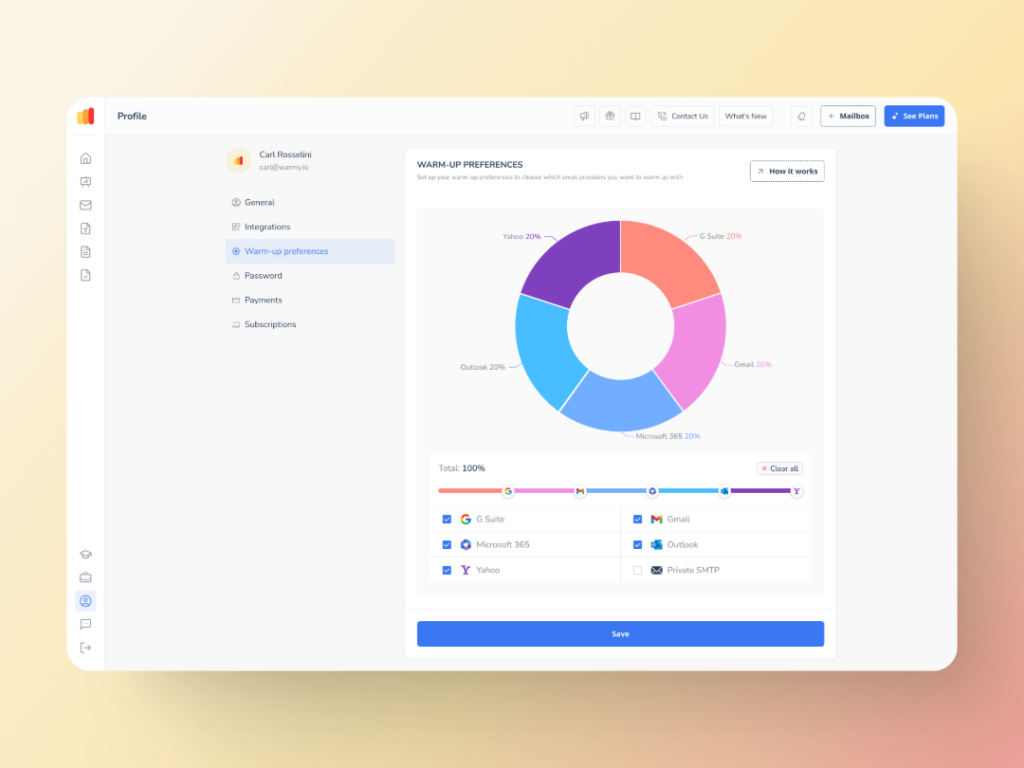With all the focus on content, subject lines, and targeting, it seems that we usually overlook the role that your email infrastructure—your mailboxes, that is, your recipients—plays in the success of your email campaigns today more than ever.
All of these factors make it crucial to have accurate mailbox planning, which will ensure your emails land in inboxes and avoid being flagged as spam. One wrong step and your open rates could drop through the floor, your bounce rates could soar, and you could find your sender reputation in tatters.
One mistake commonly made by businesses is to overload one mailbox by sending too many emails from it. This can backfire and set off the spam filters and send your emails to the spam folder. On the other end, having too many mailboxes can create clutter—making outreach management a challenge and adding bloat to the workflow.
In this guide, we’ll help you figure out how many mailboxes you should actually use for your outreach strategy to succeed. We’ll also show you some mailbox warm-up tools that can help you guarantee that your emails are being sent from trustworthy, well-maintained mailboxes.
Let’s take a deep dive into your mailbox management needs
When it comes to devising a strategy for your email outreach, it’s worth keeping in mind that mailbox management is not a one-size-fits-all type of strategy. The number of mailboxes you need depends on the size of your team, your outreach goals, and the volume of emails you plan to send.
Mismanagement and oversight of this aspect of your strategy may result in deliverability issues, including too many emails being sent from—and potentially contributing to the degradation of—a single mailbox or too many mailboxes adding unwanted complexity and inefficiency to your workflow.
In this section, we’ll dive into how to determine the right number of mailboxes for your specific needs, based on the size of your team, the goals of your outreach, and the scale of your campaigns.
🔖 Read more: Mailbox Math How to Optimize Sending Volume Without Hurting Deliverability
Team size impacts your mailbox strategy
If you only have a small team or you’re a one-man show, it may make sense to go easy with just a couple of mailboxes. But, as your team members increase and your sendout levels rise, so does the need for more mailboxes to effectively distribute the workload.
- Small teams (1–3 people): Small teams or lone wolves usually don’t require that many mailboxes. One or two should be enough—especially if you only have a few contact lists too. Your focus should be on the quality of your outreach, personalization efforts, and maintaining a good sender reputation.
- Medium teams (4–10 people): As your team continues to grow, so do your outreach needs. You may decide to spread your emails across a few mailboxes to stop you from overloading one. For teams of this size, you usually require 3-5 mailboxes. The objective is for volume and deliverability to be in equilibrium.
- Large teams (10+ people): Larger teams will need a more comprehensive mailbox strategy, with 5 or more mailboxes. At this size, outreach is very granular. The right mailbox spread ensures each email sender operates within optimal limits. You might also need an advanced method of handling and rotating mailboxes to keep up the deliverability and to avoid the spam traps.
Influence of outreach goals on mailbox usage
Your outreach objectives are closely related to your mailbox requirements. How many mailboxes you need will depend on whether you want high-volume outreach or a highly personalized one.
- High-volume outreach: If you are doing massive amounts of outreach (such as cold emailing a giant list), you will want more mailboxes to distribute the load across. This also lowers the chance of tripping spam filters by sending too many emails from a single address. With this type of outreach, you’d typically need about 5 to 10 inboxes to execute such an outreach, especially if you are planning for thousands of emails to go out each day.
- Personalized, targeted emails: If your outreach focuses more on personalized, targeted emails to a smaller, more defined group of prospects you will require less mailboxes. With far less volume going out, you can afford to do this with a smaller pool of mailboxes (let’s say 1-3) and really concentrate on getting each of them warmed up properly.
- Balanced outreach: For teams that implement both high-volume and personalized approaches, it’s best to segment outreach tasks. Use fewer mailboxes for custom outreach efforts and larger volumes for high-velocity campaigns, all while rotating mailboxes to keep your sender reputation healthy.
The dangers of mismanaging mailboxes
Mailbox planning is key for keeping a healthy email outreach program. Getting it wrong—whether by having too few or too many mailboxes—can be extremely costly for your business.
Too many mailboxes can cause too many problems
On the surface, more mailboxes sounds like a good strategy to spread the load and improve deliverability, but in fact too many mailboxes can cause major issues.
- One of the biggest challenges is the overhead involved in managing them. Not only do you have to track, maintain, and rotate all those mailboxes as you add more, it is also a very complex system—especially when you’re trying to ensure each mailbox is properly warmed up and monitored.
- Also, rotating mailboxes can be less than ideal as well. In the absence of automation, rotation will often result in some mailboxes being overused and others being neglected. The result is deliverability being compromised. The more mailboxes you have, the more challenging it is to maintain a high quality, high performing outreach strategy.
Too few mailboxes can lead to fewer success stories
On the other hand, using too few mailboxes can also be equally damaging to your outreach.
- When you max out one mailbox by sending emails from it too much, you’re setting your email deliverability up for failure. By overworking one mailbox, you only raise the probability of that mailbox being marked as suspicious—leading to bad sender reputation and, as a result, to future emails being automatically redirected to the spam folder.
- This damage to sender reputation does not limit itself to a single email campaign—it can take a long time for your domain reputation to recover. If your mailbox or domain get tagged as a source of spam, email service providers (ESPs) such as Gmail and Outlook can block or delay its delivery—which can stall your engagement stats and sales.
How Warmy’s tools can help you manage mailboxes and maximize email outreach
Mailbox management doesn’t have to be complicated. With the right tools, you can automate a lot of this process which not only results in stronger deliverability, but enables you to easily scale your outreach.
Warmy offers a range of powerful features designed to assist you in managing your inboxes efficiently and make the best out of your outreach through email. Here’s how Warmy can help your team to make managing your mailboxes simpler and more effective.
Mailbox Calculator

One of the first steps in managing your email outreach effectively is determining how many mailboxes you need. Warmy’s Mailbox Calculator takes the guesswork out of the equation. This tool helps you estimate the optimal number of mailboxes and domains for your campaigns based on your daily sending requirements.
There are just three simple steps to go through:
- Enter the number of emails you would like to send per day
- Enter how many emails you would like each mailbox to send
- Enter how many mailboxes you want to have per domain
By automating sending volume calculations, you save time and reduce errors that can pop up from manual estimations and trial-and-error incidents. With the Mailbox Calculator, you can set yourself up for success from the start and focus more on crafting effective content.
AI-powered warmup

Once you’ve calculated your ideal mailbox count, the next step is ensuring those mailboxes are properly warmed up to maintain good deliverability. Here’s where Warmy’s AI-powered warmup automates the process of gradually increasing your email sends, so your mailboxes build a positive sender reputation over time.
Instead of manually managing the warm-up process, you can trust Warmy to adapt to your specific needs, tailoring the warm-up strategy based on criteria such as mailbox age, domain reputation and email distribution schedule. This way, you will keep your mailboxes clean and your emails out of spam traps.
Warmup Preferences

Every email outreach strategy is different, and Warmy understands that. With Warmup Preferences, you can customize the distribution of the warmup process across providers. Senders can also choose if they want to use B2B or B2C customers for engagement patterns so the warmup process is tailored to their business type.
Advanced Seed Lists

Warmy’s Seed Lists are actual email addresses that simulate real human behavior. Emails are opened, read, scrolled through, and clicked—training ESPs that you are credible, trustworthy, and your emails are relevant to the recipients. And if some emails slip through to the spam folder, they are deleted and marked as important.
When you send your campaigns to these seed addresses, Warmy gives you constructive feedback regarding your inbox placement of various ESPs. It is this data that allows you to quickly spot deliverability issues and refine your approach in order to achieve better placement rates on your intended audience.
Avoid the guesswork and move towards a clear direction with Warmy
Mailbox planning doesn’t have to be a guessing game. It doesn’t matter if you are new to email outreach or need to scale your current campaigns— you need to have a clear plan to manage your mailboxes to ensure long-term success.
Try Warmy.io’s Mailbox Calculator Tool today and automate your planning process to ensure that you’re on the right track for scaling your email outreach. To maximize Warmy’s full suite of tools, sign up for a free trial today.











